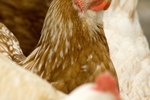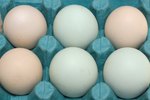
Providing easily accessible nest boxes is farmers' simple way of preventing them from hiding eggs in secluded nests throughout your yard. Constructed from durable materials, such nest boxes have hard floor of wood or metal; they need padding to prevent eggs from breaking when they fall. Straw is a traditional favorite; hay has distinct disadvantages.
Disadvantages of Hay
Chickens love picking the leaves from alfalfa hay. But, while it may sound charming for your hens to be able to nibble while they are sitting on the nest, most won't want a snack while they are passing an egg. Other chickens who are not laying eggs will be attracted to the nest box for the wrong reason, and will begin scratching around to pick at leaves. This can result in broken eggs, or a laying hen being disturbed or chased from the box.
Advantage of Straw
Oat straw provides a soft, comfortable base for your nest box that won't attract your other chickens to jump in and try to eat it. Less foot traffic in the nest box by curious non-layers means fewer broken eggs and less feces to clean up. The straw absorbs the moisture from fresh-laid eggs without sticking to the eggs, keeping the box and eggs fresh and clean. You can use soiled straw as a nitrogen-rich mulch for your garden.
References
Photo Credits
-
David De Lossy/Photodisc/Getty Images
Writer Bio
Indulging her passion for vacation vagary through the written word on a full-time basis since 2010, travel funster Jodi Thornton-O'Connell guides readers to the unexpected, quirky, and awe-inspiring.



